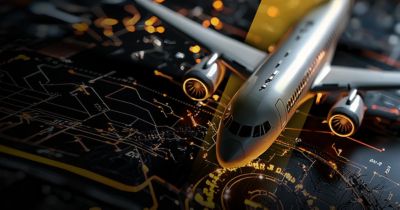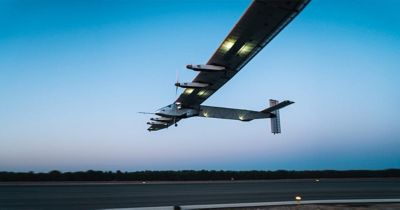-
United States -
United Kingdom -
India -
France -
Deutschland -
Italia -
日本 -
대한민국 -
中国 -
台灣
-
Ansys는 학생들에게 시뮬레이션 엔지니어링 소프트웨어를 무료로 제공함으로써 오늘날의 학생들의 성장을 지속적으로 지원하고 있습니다.
-
Ansys는 학생들에게 시뮬레이션 엔지니어링 소프트웨어를 무료로 제공함으로써 오늘날의 학생들의 성장을 지속적으로 지원하고 있습니다.
-
Ansys는 학생들에게 시뮬레이션 엔지니어링 소프트웨어를 무료로 제공함으로써 오늘날의 학생들의 성장을 지속적으로 지원하고 있습니다.

Honeywell’s products can be found from the nose to the tail of an aircraft, whether it be for commercial, defense, or business aviation.
“We have products that span pretty much every system that's on these aircraft,” says Todd Giles, chief technology officer for Honeywell Aerospace Technologies. “We’re focused on the future of flight and the next generation of aviation.” And this is true for everything from advanced air mobility (AAM) to engine optimization to enhance efficiency across different areas of the aerospace field.
Of course, throughout all these areas, safety remains Honeywell’s top goal. “(Keeping) everybody onboard the aircraft safe is the No. 1 priority for us at Honeywell,” says Giles’ colleague Walt Smith, senior director of engine systems and component analysis at Honeywell’s Engines and Power Systems group.
To achieve these rapid advancements in the aerospace field, Honeywell is turning to simulation technology. By avoiding costly and time-consuming physical prototypes, the company is able to easily account for all engine components during optimization, enhance engine efficiency, and decrease time to market so designs can take flight sooner.
Improving Engine Sustainability in Aerospace
Honeywell is committed to increased sustainability initiatives and being carbon neutral by 2035, Giles says. “We are moving toward the future of aviation and zero-emission aviation by 2050,” he continues.
To meet these goals, Honeywell is making progress in a variety of areas, from investigating the future use of green hydrogen to reducing emissions at its factories and creating more efficient engines that we can use today. “We’re involved in many aspects of driving the future of aviation,” says Giles.
One example of this work is designing combustion systems with low emissions that use small, lightweight, and high-performance engines. For this work, “as with everything in aerospace, it's all about size, weight, and power,” he says. “It's optimizing a multivariate problem on emissions, power, weight, and size.”
While designing and optimizing such a system would historically be time-consuming and expensive with many costly physical tests, simulation provides another way to meet both the performance and emission requirements of a combustion engine. With simulation, the Honeywell team can iterate on designs before committing to a full-scale launch.
“We utilize Ansys products to understand the overall engine architecture right upfront,” says Smith. “From a system design standpoint, we need to make sure that the overall engine backbone and all the structural integrity of the associated components are proper, meet requirements, and have the right safety margins.”
As Giles adds, to avoid having to create many physical prototypes, it’s important to perform the simulations needed to get the design right the first time.
Using simulation has resulted in concrete benefits for the Honeywell team. “From a combustion system standpoint, going from hundreds of tests as years go by to one or two makes a huge impact,” says Smith. In fact, he says Honeywell has seen an overall reduction in cycle time for its engine design process of more than 30%. “And a good portion of that is due to Ansys products and their help in the simulation world,” Smith says. “Ansys plays a key role in the design of our engines.”
Simulation animation showing heat in an engine design
With Ansys simulation software, the Honeywell team is continuously working toward optimizing for multiple goals in its engines — including fuel burn efficiency — while maintaining safety margins in designs. In this way, Honeywell is moving closer to its emission goals and helping to create a more environmentally friendly future for aviation.
The Importance of Taking a Multiphysics Approach
When designing the next generation of aircraft engines, the Honeywell team knows that it needs to take a comprehensive approach. “There are many physics-based analysis skill sets that are involved,” says Smith. Beyond structural mechanical analysis, there are aerodynamics, thermodynamics, fluid dynamics, and more to consider. “We're combining these analyses from a multiphysics standpoint and leveraging the Ansys tool suite to help us do that,” says Giles. Specifically, Smith notes that the Honeywell team uses Ansys LS-DYNA crash simulation software, Ansys Fluent fluid simulation software, Ansys Forte internal combustion engine design software, and Ansys optiSLang process integration and optimization software to iterate and improve their designs.
As an example of its multiphysics analyses, let’s consider aeroacoustics-related issues in a modern engine. No one on a flight wants to hear excessively loud or unexplained noises from the engines. But how can we reduce such noises?
Aeroacoustics has historically been difficult to analyze or predict. “Working with Ansys, we have now developed a modeling and simulation approach that allows us to look at aeroacoustics upfront, predict it, and design around it,” says Smith. “We need to make sure that the airflow is smooth, uninterrupted, and doesn't produce anything like a stall or surge.” Additionally, Honeywell engineers are able to consider the pressure and temperature changes in the engine to ensure that the engine system can handle all the stresses associated with these changes. For instance, its aviation acoustics simulation analyses enabled the Honeywell team to understand how the aeroacoustics will impact the overall system upfront, before proceeding to the hardware development stage. Through this type of analysis, the team can figure out how different parts in a system interact — which is important to know because improving one area of the design could harm another part.
Taking a multiphysics simulation approach allowed Honeywell to design changes to the engine that the company was able to put into the production system early in the design process, which decreased time to production, says Smith. “We were able to go directly to production because of the accurate results of the simulation prediction.”
Continuing the Legacy of Aerospace Innovation
For the decades that Honeywell has been on its digital journey, simulation has played a huge role. Looking back on this time, “the Ansys partnership has been tremendous for us,” says Giles. “We've been able to affect the product roadmap and product capabilities. We've been able to learn from Ansys on what we can do differently, as well as new ways of thinking, new workflows, and new optimization techniques. I think it's been a great relationship of give-and-take.”
As for what’s coming next, Honeywell has the future of aviation in sight, says Smith. “We not only look at the near-term needs of the customer base but the market and what's necessary in the longer run,” he says. Honeywell’s continued partnership with Ansys will help the company keep an eye on the future in an efficient, cost-effective, and comprehensive way.
Giles and Smith share more about Honeywell's journey in this video.
To learn more about how simulation is transforming the aerospace field, visit the Ansys aerospace page.
Just for you. We have some additional resources you may enjoy.
"Ansys plays a key role in the design of our engines."
— Walt Smith, senior director of engine systems and component analysis, Honeywell’s Engines and Power Systems group
The Advantage Blog
The Ansys Advantage blog, featuring contributions from Ansys and other technology experts, keeps you updated on how Ansys simulation is powering innovation that drives human advancement.














